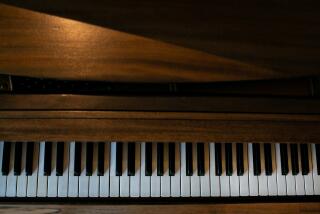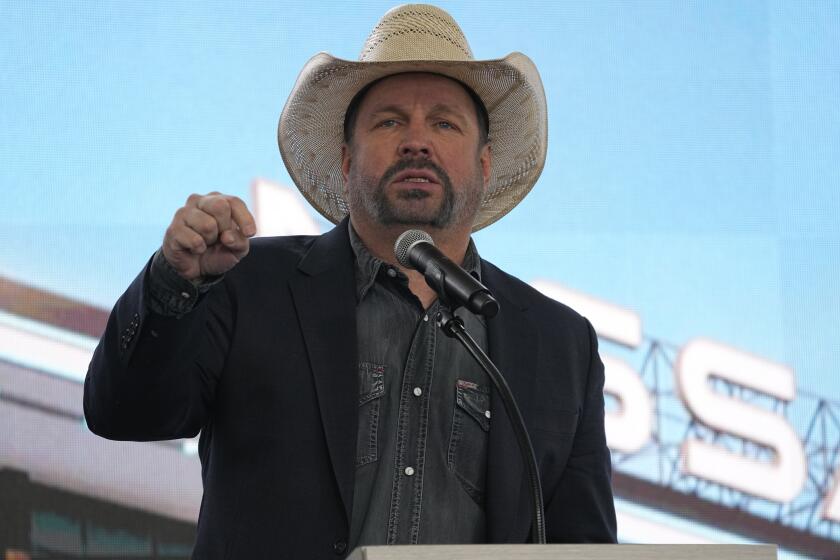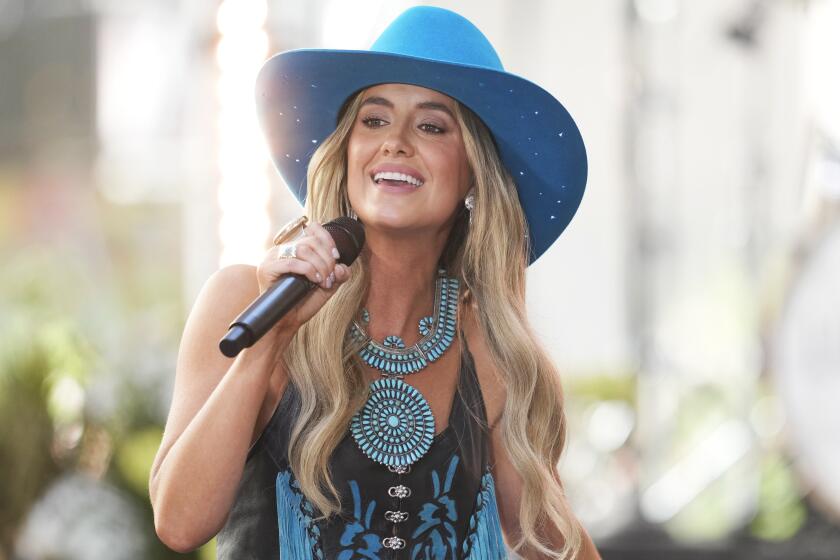Elliott Carter dies at 103; inventive American composer
Elliott Carter, the great American composer who was born in the horse-and-buggy era but whose music persistently looked ahead by reflecting and unabashedly celebrating the intricacies of modern life, died Monday of natural causes at his home in New York, according to his close friend and assistant, clarinetist Virgil Blackwell. He was 103.
Not only did Carter long outlive all of the significant composers of his generation, he astonished the musical world by remaining inventive and prolific up to the end. On Oct. 25, Los Angeles Philharmonic musical director Gustavo Dudamel conducted the world premiere of Carter’s most recent piece, “Dialogues II,” at La Scala in Milan.
“This is music that comes from a very deep soul,” Dudamel said Monday night. “While we mourn his loss, what he achieved as a composer, as an artist and as a creator will be eternal. I am very honored to have been a part of this.”
Carter was never a favorite with general audiences because of the complexity of his works, but he ultimately wore down his detractors and was in such demand that two months before his 97th birthday in 2005, he had competing premieres given by the Boston Symphony and the Chicago Symphony on the same night. His 100th birthday was celebrated at Carnegie Hall with more premieres, and every subsequent birthday brought new works.
The third of “the three Cs” of American music, Carter, like his contemporaries Aaron Copland and John Cage, did much to define the American sound in the 20th century. Restless, inquiring and perpetually up to date, his music tended to be ever-changeable, and his most important contribution was rhythmic invention. He resisted a constricting regular pulse, seeking instead a more organic way of thinking about time.
In his Second String Quartet, for instance, each instrument has a distinct personality with its own musical intervals, melodic materials and its own rhythmic gait. Like characters in a play, the two violins, viola and cello are constantly coming and going, entering into competition or conflict, falling in and out of love. Eventually, they learn to get along.
Carter’s sense of rhythm and meter had its mathematical component as well. He experimented with the effects of playing different melodies at different speeds at the same time. But this technique, rather than making everything sound at cross purposes, rewarded anyone willing to concentrate hard enough with the experience of relativity without the bother of space flight.
For Carter, this was the poetry of science, and for all his technical innovations, poetry and often pretty difficult poetry, was usually his inspiration. He was fluent in several languages, and in old age, when he tired after a morning of composing, his idea of taking it easy was to read Goethe in German, Proust in French or Dante in Italian.
Not surprisingly, then, Carter never composed for the casual listener. His most complicated scores, where everything is in perplexing flux, can at first seem to approach a state of chaos. But after repeated hearings, a listener eventually sorts out the various intertwining lines and meters, and the fragmentary gibberish reveals its fascinating inner workings and purpose.
Such music creates extraordinary difficulties for the performer. But although Carter suffered more than his share of inadequate performances, he was championed by many of the finest musicians of his day. The Juilliard String Quartet made a specialty of his five string quartets, a cycle now considered in a class with those by Béla Bartók and Arnold Schoenberg.
Among conductors, Carter received ferocious support from Pierre Boulez at the New York Philharmonic in the 1970s and later from Daniel Barenboim at the Chicago Symphony and James Levine at the Boston Symphony. He received greater acceptance in Europe, where state-supported orchestras typically have more rehearsal time and where audiences associate difficulty with substance.
Elliott Cook Carter was born in New York City on Dec. 11, 1908. His father, a lace importer who traveled regularly to France, often took him on trips abroad and taught him French at a young age. But his early musical education was limited to standard piano lessons.
Classical repertory, he said, didn’t interest him as a teenager, but the rise of Modernism in the ‘20s did. He was fired up by what he encountered in Paris — as a teenager he bought one of the first copies of James Joyce’s novel “Ulysses,” which was banned in the United States. All the latest art in the New York of the time appealed to him, whether the visual experiments of the Surrealists and Dadaists or music by Stravinsky, Schoenberg, Ravel, Scriabin and Varèse.
At 16, he was introduced to composer Charles Ives, who encouraged the teenager to pursue a career in music and wrote him a recommendation to Harvard, noting that “his reliability, industry, and sense of honor are what they should be — also, his sense of humor — which you do not ask me about.”
At Harvard, Carter majored in English literature, classical Greek and philosophy as well as music. He attended all the important premieres in Boston and New York. In 1931, he found himself seated next to George Gershwin when Leopold Stokowski conducted the first American performance of Alban Berg’s “Wozzeck” in Philadelphia.
After earning a master’s in music in 1932, Carter still felt his technique inadequate. Following in the footsteps of Copland and other young Americans, he spent three years in Paris studying with famed pedagogue Nadia Boulanger, who put him through his paces in counterpoint. This, Carter later claimed, was what made it possible for him to indulge in his fancy for producing musical lines of radically different character.
But he was not satisfied with any of his early musical experiments and destroyed them all. Upon returning to New York in 1935, he became the music director of Ballet Caravan, the forerunner of New York City Ballet, and began writing in a populist style. The climate of the times — the Depression and the run-up to World War II — as well as the practical necessities of dance music, Carter felt, demanded something audience-friendly.
During the war, Carter, whose allergies prevented him from enlisting, worked for the Office of War Information and wrote an upbeat, Coplandesque “Holiday” Overture and First Symphony. But even in these, he peppered his populism with dissonance, thorny counterpoint and dense instrumental textures.
After the war, Carter wrote two large-scale sonatas, one for piano and one for cello and piano, in which he developed a technique that came to be known as metric modulation. Through mathematical rhythmic relationships that created imperceptibly changing meters, his music shifted from one pulse to the next the way automatic transmissions seamlessly shifted gears. A listener could tell that something had changed, but not right away and not exactly how.
As part of a journey of self-discovery, Carter spent the fall of 1950 to the spring of 1951 in the lower Sonoran Desert in Arizona, where he became fascinated by the weather and exotic wildlife. There, for the first time, he wrote a work intended to satisfy only himself. In a study of Carter’s music, the composer David Schiff said the daunting 40-minute First String Quartet “is probably the first musical composition to rival the formal daring of Eliot, Joyce, Proust or Eisenstein.”
With the work’s wispy scurrying scherzo, glacially irregular slow movement and constantly accelerating set of variations (all to become Carter trademarks), the composer made no compromises for performer or listener, and he seriously doubted that the quartet would ever be performed. But the premiere by the Walden Quartet at Columbia University in 1953 proved a sensation, and Carter was suddenly seen as one of America’s most important and original musical voices.
The quartet gave Carter the courage to follow his convictions and never look back, making him a darling of intellectuals but alienating him from a wider public. Still, his “Variations for Orchestra” was not completely off-putting, and his reputation took another large leap when Stravinsky called his “Double Concerto for Piano and Harpsichord,” which begins in full-fledged pandemonium, a masterpiece of American music.
Like most serious composers of the time, Carter taught in order to supplement his income, holding a succession of posts at the Peabody Conservatory, Columbia University, Queens College, the City University of New York, Yale University, MIT, Cornell University and the Juilliard School. His music became equally restless. His pieces tended more and more toward fragmentation, and he developed elaborate structural systems to hold together the collections of thick chords, jagged melodic intervals, fidgety rhythms and competing meters.
All of this, along with the fact that he hated to repeat himself and insisted upon giving himself a new challenge with each score, meant that Carter worked slowly, producing a major work only every year or two throughout the ‘50s, ‘60s and ‘70s. Despite the success of his First Quartet, he didn’t write his Second String Quartet until 1959, and the piece had a radically different character. Similar time periods separated the pointillist third, the emotionally direct fourth and the autumnal fifth quartets.
At the request of Leonard Bernstein and the New York Philharmonic, he wrote his somewhat Impressionistic “Concerto for Orchestra” in 1969; seven years later, he delivered his big orchestral work, the schizophrenic, split-screen “Symphony of Three Orchestras,” to the same orchestra, but this time for Boulez.
Between 1975 and 1981, Carter wrote three penetrating song cycles, to poems by Elizabeth Bishop (“A Mirror on Which to Dwell”), John Ashbery (“Syringa”) and Robert Lowell (“In Sleep, in Thunder”). He also composed chamber works and a large stream-of-consciousness piano solo, “Night Fantasies.”
In these late works, Carter’s style did not become appreciably simpler, but it did become more elegant, as he continually refined his techniques and searched for deeper poetic content. But with his late, late style, the music from his 80s onward, something remarkable happened: He found he could write more intuitively and more quickly. And as in his works where different events happen at different speeds and on different scales simultaneously, he seemed to compose that way.
For the rest of his life, he kept up a constant stream of small occasional pieces, intricate but lighter in tone. The third of the “Three Occasions for Orchestra” from 1989 was a 50th anniversary present for his wife, sculptor Helen Frost Jones.
On a medium-sized scale, he turned to a series of dramatic concertos for oboe, violin and clarinet. In his 90th year, 1998, he completed his largest work, “Symphonia: sum fluxae pretium spei,” a candidate for the great American symphony. In 1999 he wrote his only opera, “What Next?,” to a libretto by the British critic Paul Griffiths. The 50-minute symphony — a triptych of self-sufficient movements — takes its title, “I am the prize of flowing hope,” from a 17th century Latin poem by Richard Crashaw and is an extended study of unstoppable musical flow. The impetus for “What Next?” was a Jacques Tati film, “Traffic,” and the convoluted comic opera reveals that Carter’s wit in old age had become, if anything, more absurdist.
Carter slowed down in the early part of the new century when his wife became ill. But after her death in 2003, he bounced back, writing a dazzling array of ever-new music, including such remarkably titled works by a centenarian as “On Conversing with Paradise,” and “What Are Years.” His final work, “Instances,” will be given its premiere by the Seattle Symphony in February.
Carter received most of the honors society accords a composer, including two Pulitzer Prizes, the Sibelius Medal, the Gold Medal of the National Institute of Arts and Letters and the National Medal of the Arts.
He is survived by a son, David, of Spencer, Ind., and a grandson, Alexander.
More to Read
The biggest entertainment stories
Get our big stories about Hollywood, film, television, music, arts, culture and more right in your inbox as soon as they publish.
You may occasionally receive promotional content from the Los Angeles Times.











